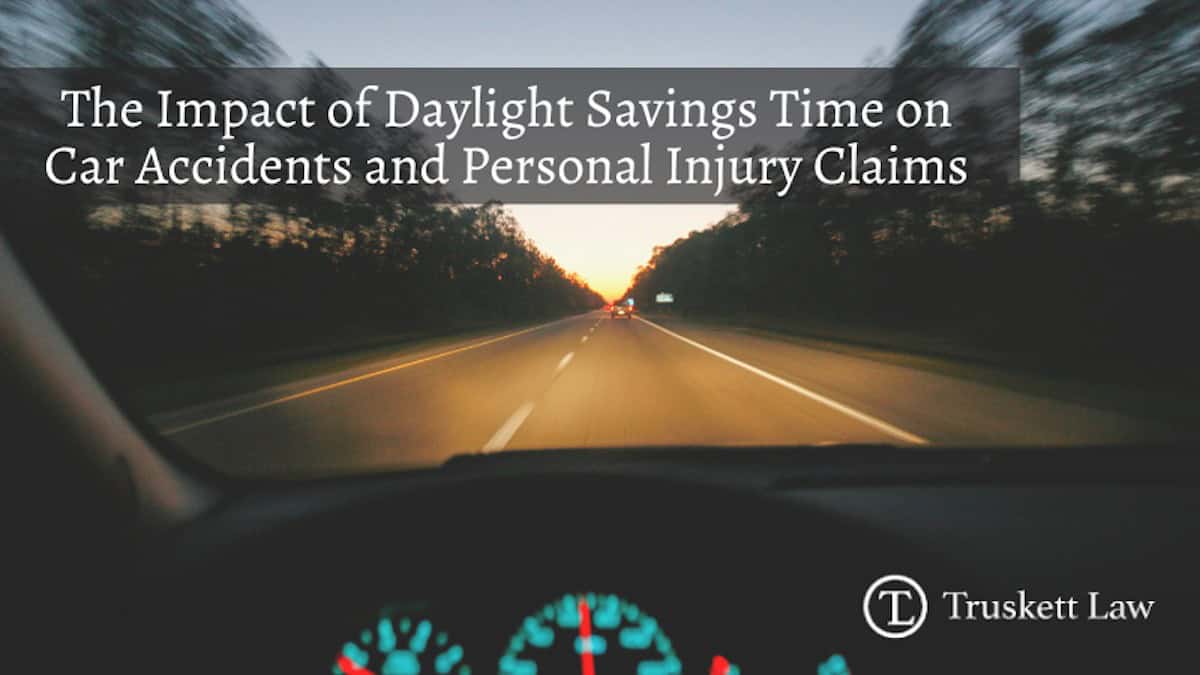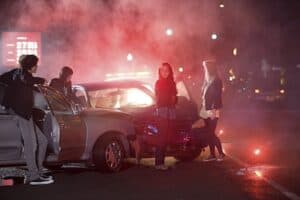
23 Oct The Impact of Daylight Savings Time on Car Accidents and Personal Injury Claims
Car Accidents During Daylight Savings Time
Daylight Savings Time (DST) is a biannual event in which clocks are adjusted forward or backward to make better use of daylight hours. While the idea behind DST is to increase daylight and energy savings, it can have unintended consequences, particularly on road safety.
Studies have shown that the shift in time can lead to a noticeable increase in car accidents. This article will explore the impact of DST on car accidents and personal injury claims, providing insight into why this phenomenon occurs and what drivers and accident victims should know.
Understanding Daylight Savings Time
What Is Daylight Savings Time?
Daylight Savings Time is the practice of moving the clock forward by one hour in the spring (commonly referred to as “spring forward”) and moving it back by one hour in the fall (“fall back”). This change is meant to extend evening daylight hours, reducing the need for artificial lighting and providing more daylight for outdoor activities.
In the United States, DST typically starts on the second Sunday in March and ends on the first Sunday in November. However, the time change is not observed in every state or region, with places like Arizona and Hawaii choosing to stay on standard time year-round.

The Effects of DST on Sleep Patterns
While an extra hour of daylight might seem beneficial, the transition can disrupt sleep patterns. The “spring forward” shift, in particular, leads to a loss of one hour of sleep, which can negatively impact people’s sleep cycles.
This disruption can result in a temporary state of sleep deprivation, which has been linked to decreased alertness, impaired cognitive function, and increased reaction times.
The Connection Between Daylight Savings Time and Car Accidents
Increased Risk After the Time Change
Numerous studies have found that car accidents tend to spike in the days immediately following the start of Daylight Savings Time. One reason for this is the disruption to sleep schedules that occurs when people lose an hour of rest during the spring shift.
This loss of sleep leads to driver fatigue, which is a significant contributor to car accidents. Drowsy driving can be just as dangerous as driving under the influence of alcohol, as both impair reaction times and decision-making abilities.
A study by the University of Colorado Boulder found that fatal car accidents increase by 6% during the week following the springtime change. This alarming statistic highlights the dangers posed by even a slight disruption in sleep patterns and the increased risk for drivers and pedestrians alike.
Reduced Visibility in the Morning
When clocks are moved forward in the spring, many commuters find themselves driving in the dark during the early morning hours. This sudden change in light conditions can increase the risk of accidents, especially for those unaccustomed to driving in the dark.
Pedestrians and cyclists are also at greater risk during this time, as drivers may struggle to adjust to the reduced visibility.
Impact on Evening Commutes in the Fall
Conversely, when DST ends in the fall and clocks are set back an hour, the sun sets earlier, affecting evening commutes. While drivers may have had daylight for their drive home during the summer months, they suddenly find themselves commuting in darkness.
This transition can catch drivers off guard, especially in areas where the time change occurs alongside shifts in weather conditions, such as rain, fog, or snow.
How Driver Fatigue Contributes to Accidents After DST
Understanding Driver Fatigue
Driver fatigue is a state of mental or physical exhaustion that impairs a driver’s ability to operate a vehicle safely. It is caused by a lack of sleep, extended periods of driving, or disruptions to a person’s sleep schedule—such as the one caused by DST.
Fatigued drivers experience slower reaction times, reduced attention, and impaired judgment, all of which significantly increase the risk of accidents.
The Role of Sleep Deprivation in Car Accidents
The American Automobile Association (AAA) estimates that drowsy driving contributes to approximately 16-21% of all fatal crashes each year. After the “spring forward” time change, the reduction in sleep can exacerbate this problem, leading to a temporary surge in drowsy driving-related accidents.
Drivers who are already sleep-deprived are particularly vulnerable, as losing even a single hour of rest can further impair their ability to drive safely.

The Impact of DST on Personal Injury Claims
How DST-Related Accidents Affect Personal Injury Claims
When a car accident occurs during the period following DST, it can complicate personal injury claims. Insurance companies may attempt to argue that driver fatigue or poor visibility – both common after the time change – were contributing factors to the accident.
However, this does not absolve drivers of their responsibility to drive safely, nor does it prevent injured parties from seeking compensation for their injuries.
If you are involved in an accident during the DST transition, it’s essential to document the circumstances of the crash thoroughly. This includes noting the time of day, weather conditions, visibility, and any signs of driver fatigue. These details can be critical in determining fault and building a strong personal injury claim.
Proving Negligence in DST-Related Accidents
In any personal injury case, proving negligence is a key component of securing compensation. Negligence refers to a driver’s failure to exercise reasonable care, leading to an accident.
In the case of DST-related accidents, negligence might involve a driver’s decision to operate a vehicle while fatigued or their failure to adjust to changing light conditions.
A personal injury lawyer can help gather evidence to prove that the other driver’s negligence caused the accident. This might include witness statements, police reports, and expert testimony on the effects of DST on driving performance.
Tips for Staying Safe on the Road During DST Transitions
1. Prioritize Sleep
One of the best ways to protect yourself and others on the road during the DST transition is to prioritize sleep. Make an effort to go to bed earlier in the days leading up to the time change, especially during the spring shift. Getting adequate rest will help you adjust to the new schedule and reduce the risk of drowsy driving.
2. Adjust Your Driving Habits
Be mindful of how the time change affects visibility during your commute. If you find yourself driving in darkness when you’re not used to it, take extra precautions. Reduce your speed, increase your following distance, and be alert for pedestrians, cyclists, and other drivers who may also be adjusting to the new conditions.
3. Stay Cautious at Intersections
Intersections are particularly dangerous during the DST transition, as drivers may be more prone to errors due to fatigue or reduced visibility. Approach intersections with caution, and always double-check for oncoming traffic before proceeding, even if you have the right of way.
4. Avoid Distracted Driving
Fatigue and distractions are a deadly combination. During the DST transition, it’s more important than ever to avoid distractions while driving. Put away your phone, limit other in-car distractions, and focus entirely on the road.
What to Do If You’re Involved in a DST-Related Accident
Seek Medical Attention
If you’re involved in a car accident during the DST transition, your health should be your top priority. Even if you feel fine, it’s essential to seek medical attention as some injuries may not be immediately apparent. A doctor can evaluate you for any hidden injuries, such as whiplash or concussions, which are common in car accidents.
Document the Accident
After ensuring your safety and seeking medical attention, document the accident as thoroughly as possible. Take photos of the scene, including any damage to the vehicles involved, road conditions, and lighting conditions. If there were any witnesses to the crash, get their contact information for future reference.
Contact a Personal Injury Lawyer
Navigating the aftermath of a car accident can be challenging, especially if you’re dealing with injuries and insurance claims. A personal injury lawyer can help you understand your legal options, negotiate with insurance companies, and build a strong case for compensation.
In cases where driver fatigue or other DST-related factors contributed to the accident, a lawyer can provide valuable guidance on how to proceed.
Conclusion
Daylight Savings Time may offer more daylight hours, but it also brings increased risks on the road, particularly in the days immediately following the time change.
By understanding the risks associated with DST and taking proactive measures to stay safe, drivers can reduce their chances of being involved in an accident and better navigate the potential legal implications if an accident occurs.


Sorry, the comment form is closed at this time.